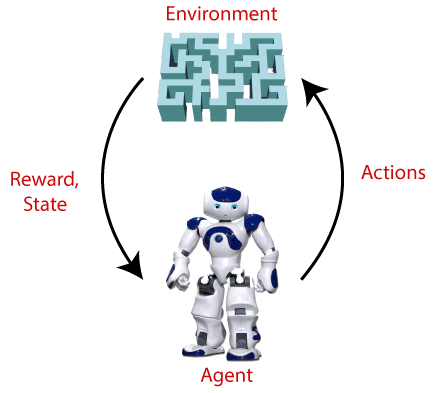What is Reinforcement Learning?
- Reinforcement Learning is a feedback-based Machine learning technique in which an agent learns to behave in an environment by performing the actions and seeing the results of actions. For each good action, the agent gets positive feedback, and for each bad action, the agent gets negative feedback or penalty.
- In Reinforcement Learning, the agent learns automatically using feedbacks without any labeled data, unlike supervised learning.
- Since there is no labeled data, so the agent is bound to learn by its experience only.
- RL solves a specific type of problem where decision making is sequential, and the goal is long-term, such as game-playing, robotics, etc.
- The agent interacts with the environment and explores it by itself. The primary goal of an agent in reinforcement learning is to improve the performance by getting the maximum positive rewards.
- The agent learns with the process of hit and trial, and based on the experience, it learns to perform the task in a better way. Hence, we can say that "Reinforcement learning is a type of machine learning method where an intelligent agent (computer program) interacts with the environment and learns to act within that." How a Robotic dog learns the movement of his arms is an example of Reinforcement learning.
- It is a core part of Artificial Intelligence, and all AI agent works on the concept of reinforcement learning. Here we do not need to pre-program the agent, as it learns from its own experience without any human intervention.
- Example: Suppose there is an AI agent present within a maze environment, and his goal is to find the diamond. The agent interacts with the environment by performing some actions, and based on those actions, the state of the agent gets changed, and it also receives a reward or penalty as feedback.
- The agent continues doing these three things (take action, change state/remain in the same state, and get feedback), and by doing these actions, he learns and explores the environment.
- The agent learns that what actions lead to positive feedback or rewards and what actions lead to negative feedback penalty. As a positive reward, the agent gets a positive point, and as a penalty, it gets a negative point.

Terms used in Reinforcement Learning
- Agent(): An entity that can perceive/explore the environment and act upon it.
- Environment(): A situation in which an agent is present or surrounded by. In RL, we assume the stochastic environment, which means it is random in nature.
- Action(): Actions are the moves taken by an agent within the environment.
- State(): State is a situation returned by the environment after each action taken by the agent.
- Reward(): A feedback returned to the agent from the environment to evaluate the action of the agent.
- Policy(): Policy is a strategy applied by the agent for the next action based on the current state.
- Value(): It is expected long-term retuned with the discount factor and opposite to the short-term reward.
- Q-value(): It is mostly similar to the value, but it takes one additional parameter as a current action (a).
Key Features of Reinforcement Learning
- In RL, the agent is not instructed about the environment and what actions need to be taken.
- It is based on the hit and trial process.
- The agent takes the next action and changes states according to the feedback of the previous action.
- The agent may get a delayed reward.
- The environment is stochastic, and the agent needs to explore it to reach to get the maximum positive rewards.
Types of Reinforcement learning
There are mainly two types of reinforcement learning, which are:
- Positive Reinforcement
- Negative Reinforcement
Positive Reinforcement:
The positive reinforcement learning means adding something to increase the tendency that expected behavior would occur again. It impacts positively on the behavior of the agent and increases the strength of the behavior.
This type of reinforcement can sustain the changes for a long time, but too much positive reinforcement may lead to an overload of states that can reduce the consequences.
Negative Reinforcement:
The negative reinforcement learning is opposite to the positive reinforcement as it increases the tendency that the specific behavior will occur again by avoiding the negative condition.
It can be more effective than the positive reinforcement depending on situation and behavior, but it provides reinforcement only to meet minimum behavior.




No comments:
Post a Comment